Sony PCV-RZ301, PCV-RZ324, PCV-RZ321, PCV-RZ311, PCV-RZ302 User Manual
...
N
Sony VAIO Desktop
User Guide
P C V - R Z s e r i e s / P C V - 1 1 2 6

Read this first
Sony VAIO Desktop User Guide
n N
1
Read this first
Notice
© 2003 Sony Corporation. All rights reserved.
This manual and the software described herein, in whole or in part, may not be reproduced, translated, or reduced to any machinereadable form without prior written approval.
Sony Corporation provides no warranty with regard to this manual, the software, or other information contained herein and hereby expressly disclaims any implied warranties or merchantability or fitness for any particular purpose with regard to this manual, the software or such other information. In no event shall Sony Corporation be liable for any incidental, consequential, or special damages, whether based on tort, contract, or otherwise, arising out of or in connection with this manual, the software, or other information contained herein or the use thereof.
Macrovision: This product incorporates copyright protection technology that is protected by method claims of certain U.S. patents and other intellectual property rights owned by Macrovision Corporation and other rights owners. Use of this copyright protection technology must be authorised by Macrovision Corporation, and is intended for home and other limited viewing uses only unless otherwise authorised by Macrovision Corporation. Reverse engineering or disassembly is prohibited.
Sony Corporation reserves the right to make any modification to this manual or the information contained herein at any time without notice. The software described herein is governed by the terms of a separate user licence agreement.
Please note that the illustrations in this manual may not necessarily apply to your model. Please see the Specifications sheet for the specific configuration of your VAIO.

Read this first
Sony VAIO Desktop User Guide
n N
2
ENERGY STAR®
As an ENERGY STAR® Partner, Sony has determined that this product meets the ENERGY STAR® guidelines for energy efficiency. The International Energy Star® Office Equipment Program is an international program that promotes energy saving through the use of computers and their office equipment. The program backs the development and dissemination of products with functions that effectively reduce energy consumption. It is an open system in which business proprietors can participate voluntarily. The targeted products are office equipment such as computers, displays, printers, facsimiles and copiers. Their standards and logos are uniform among participating nations.
ENERGY STAR is a U.S. registered mark.
Environmental information
Halogenated flame retardant is not used in cabinets.
Cushions formed by corrugated board are used in packaging.

Read this first
Sony VAIO Desktop User Guide
n N
3
Safety information
Owner's record
The serial number and model number are located on the back of your Sony desktop. Record the serial number and the model number and refer to them if you call VAIO-Link. See also the printed Specifications document.
Warnings
General
Risk of explosion if battery is replaced by an incorrect type. Dispose of used batteries according to the instructions.
Opening the unit, for whatever reason, could lead to damages that are not covered by the guarantee.
To avoid electrical shock, do not open the cabinet. Refer servicing to qualified personnel only.
To prevent fire or shock hazard, do not expose your VAIO desktop to rain or moisture.
If reporting a gas leak, do not use the modem or a telephone in the vicinity of the leak.
Avoid using the modem during a severe electrical storm.
The power socket outlet you are using must be installed near the equipment and must be easily accessible.
Do not move your computer while the system is in Standby mode.
The magnetic properties of some objects can have serious consequences for your hard disk drive. They can erase the data on the hard disk drive and cause the computer to malfunction. Do not place your computer near or on any objects, which emit magnetic fields, mainly:
TV sets
Speakers
Magnets
Magnetic bracelets.

Read this first
Sony VAIO Desktop User Guide
n N
4
Audio/video
Audio and picture distortion may occur if this equipment is positioned in close proximity to any equipment emitting electromagnetic radiation.
Connectivity
Never install modem or telephone wiring during a severe lightning storm.
Never install telephone jacks in wet locations unless the jack is specifically designed for wet locations.
Be cautious when installing or modifying telephone lines.
To disconnect your VAIO desktop completely from the mains voltage, unplug the power cable.
Make sure that the socket outlet is easily accessible.
Optical disc drives
The use of optical instruments can cause eye hazard. As the laser beam used in this product is harmful to the eyes, do not attempt any disassembling process. For servicing, refer to qualified personnel only.
There is visible and invisible radiation when the optical disc drive is open: avoid direct exposure to the laser beam. The disc drives are classified as CLASS 1 LASER PRODUCTS and comply with the Laser Product Safety Standard EN 60825-1. Repair and maintenance only by authorised Sony technicians. Improper repairs and use can create safety hazards.
CLASS 1
LASER PRODUCT
TO EN 60825-1

Read this first
Sony VAIO Desktop User Guide
n N
5
Regulatory information
Sony hereby declares that this product is in compliance with the essential requirements and other relevant provisions of European
Directive 1999/5/EC (radio equipment and telecommunications terminal equipment Directive).
Declaration of Conformity
The European Union is targeting the free movement of goods for the internal market and to prevent technical barriers to trade. This effort has resulted in several EU Directives asking that manufacturers make their products comply with essential standards. Manufacturers are required to affix the "CE" mark on the products they sell and to draw up a "Declaration of Conformity" (DoC).
Primarily, the Declarations of Conformity are intended for the market surveillance authorities as proof that products satisfy the required standards. Additionally, Sony provides these EU DoC's on the website http://www.compliance.sony.de as a service to our customers.
You can search for all Declarations of Conformity available for a specific product by typing in the model name in the search box. A list of matching documents will be displayed and can be downloaded. Please note that the availability of declarations depends on the scope of the EU Directives and the individual product specifications.
This product complies with EN 55022 Class B and EN 55024 for use in the following areas: residential, commercial, and light industrial.
This product has been tested and found compliant with the limits set out in the EMC Directive for using connection cables not longer than 3 metres (9.8 feet).
Before activating the built-in modem, please read the Modem Regulations leaflet.

Read this first
Sony VAIO Desktop User Guide
n N
6
Disposing of the internal memory backup battery
Your Sony VAIO desktop is equipped with an internal back-up memory battery that should not have to be replaced during the lifetime of the product. If you want to replace the battery, please contact VAIO-Link:
http://www.vaio-link.com
Keep away from children.
Dispose of the battery properly at its end-of-life.
In some areas the disposal of non-hazardous batteries in household or business waste may be prohibited. Please use the public waste collection system.

Welcome
Sony VAIO Desktop User Guide
n N
7
Welcome
Congratulations on purchasing a Sony VAIO desktop. Sony has combined leading-edge technology in audio, video, computing and communications to provide you with state-of-the-art personal computing.
Here are the main features you will be able to enjoy:
Exceptional performance - Your PC includes a fast processor, an internal modem, and a fast Ethernet interface.
Dual drives – Enjoy the freedom of two disc drives*.
Sony audio and video quality – The advanced graphics card and high-quality external stereo speakers enable you to take advantage of today’s advanced multimedia applications, games, and entertainment software.
Multimedia features – Enjoy audio and video CDs and DVDs.
Giga Pocket - Take advantage of the new Giga Pocket technology, allowing you to watch TV and record your favourite programs digitally and by remote control.
Sony Memory Stick™ slot – The next generation in digital storage allows you to easily transfer images, sounds, data and text between cameras, computers, and more.
Interconnectivity – Your computer has Memory Stick™, USB 2.0, and i.LINK™ functionalities.
Windows® XP Home Edition with Service Pack 1 - Your system includes the latest consumer operating system from Microsoft®.
Excellent customer support - If you are experiencing any problems with your computer, please check the VAIO-Link website for a possible solution: http://www.vaio-link.com
Before contacting VAIO-Link, please try to solve the problem by reading this guide, especially the section Troubleshooting (page 76) or the manuals and help files for the peripherals or software.
* See the printed Specifications document for information about the drive.

Welcome
Sony VAIO Desktop User Guide
n N
8
Documentation pack
Your documentation pack contains printed information and user guides to read on your computer. The user guides are compiled in the VAIO Info Centre on the VAIO Recovery and Documentation Disc.
Printed documentation
The printed part of your documentation pack includes the following:
A Getting Started brochure, where you will find a brief description of the items in your box, and how to setup your computer;
A Specifications sheet, containing a table of specifications, a list of bundled software and, on the reverse side, a guide to setting up your VAIO;
A Guide to Troubleshooting / Using the VAIO Recovery and Documentation Disc, where you will find troubleshooting, an explanation of the purpose and use of the VAIO Recovery and Documentation Disc and VAIO-Link information;
A Dual Language Operating System leaflet*;
Your Sony Guarantee conditions;
A Safety Regulations leaflet;
A Modem Regulations leaflet.
* Depending on your country and model. Dual Language Operating Systems are available in Switzerland (German and French).

Welcome
Sony VAIO Desktop User Guide
n N
9
Online documentation
The online documentation includes the following guides:
1The Hardware Guide (this guide):
Using your VAIO Desktop shows you how to use the standard components of your system.
Connecting peripheral devices explains how you can add functionality by connecting various peripherals.
Getting help explains the support options available to you, and offers basic troubleshooting tips.
Precautions provides facts and advice about using your VAIO.
Glossary refers to terms used in this manual.
2Refer to your Software Guide for information on the software and how to use Sony applications.
About the Software is a short description of the features of the software available with VAIO systems.
Using Video software explains how to use Sony video software: DVgate and Network Smart Capture.
Managing audio files with SonicStage explains how to convert your existing MP3, WMA and WAV format audio files into ATRAC3 format.
Using PictureGear Studio explains how to get the most enjoyment out of your photographs taken with a digital camera.
Using Click to DVD explains how to capture video images from a digital external device (camera, VCR, etc.) and write them to a DVD.
Using VAIO Media explains how to enjoy music, video and photos through your home networking environment.
Customising your computer explains how to configure your modem and set a wallpaper.

Welcome
Sony VAIO Desktop User Guide
n N
10
Installing and updating applications explains how to install, run or uninstall a software application.
Managing drivers explains how to install, update or uninstall a driver.
3The Giga Pocket manual explains how to watch and record TV and video on your PC.
4In the VAIO-Link Customer Service Guide you will find all the VAIO-Link information you need, including specific contact numbers for each country.
Further sources
1Consult the Online Help files of the software you are using for detailed information on features and troubleshooting.
2Refer to the Microsoft Quick Start manual for more information on Windows®.
3Go to http://www.club-vaio.com to find online tutorials about your favourite VAIO software.
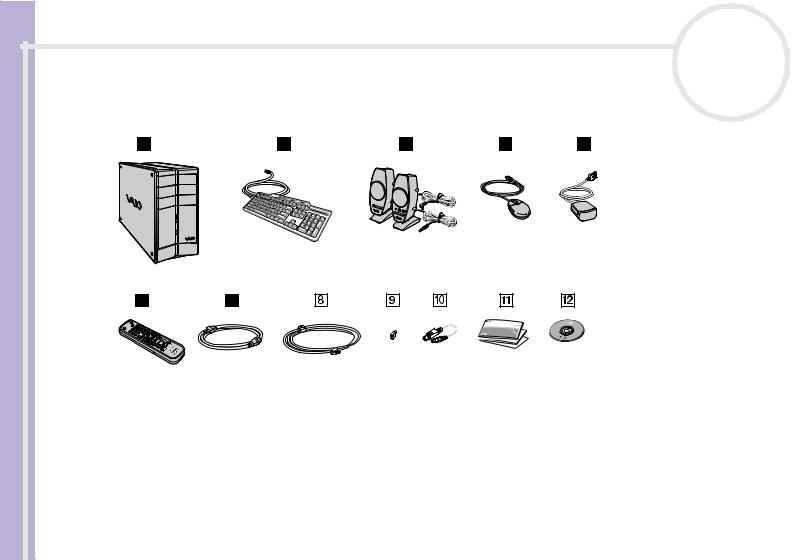
Welcome
Sony VAIO Desktop User Guide
n N
11
Your Sony VAIO desktop and its accessories
The following hardware items are in the box:
1 |
Main unit |
7 |
Power cable |
|
|
|
|
2 |
VAIO keyboard |
8 |
Phone cable |
|
|
|
|
3 |
Stereo speakers |
9 |
Phone plug adapter (country-specific) |
|
|
|
|
4 |
VAIO optical wheel mouse |
10 |
TV-Out cable |
|
|
|
|
5 |
Infrared receiver (for remote control) |
11 |
Documentation pack |
|
|
|
|
6 |
Remote control |
12 |
VAIO Recovery and Documentation Disc* |
|
|
|
|
*See the printed Guide to Troubleshooting and Using the VAIO Recovery and Documentation Disc for details. The phone cable and plug adapter are used to connect the internal modem.
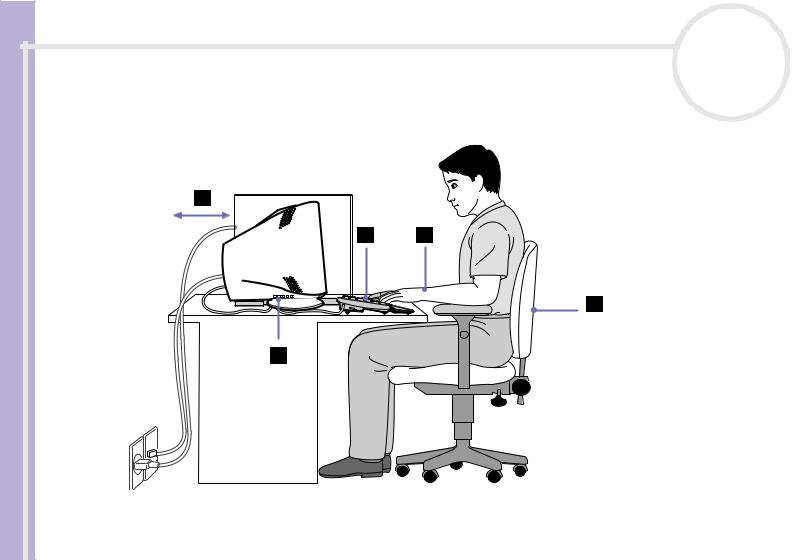
Welcome
Sony VAIO Desktop User Guide
n N
12
Ergonomic considerations
Whenever possible, try and take into account the following ergonomic considerations when using your new computer, whether at home or in the office:

Welcome
Sony VAIO Desktop User Guide
n N
13
Position of the keyboard and mouse – Place the keyboard directly in front of you (1). Keep your forearms horizontal, with your wrists in a neutral, comfortable position (2) while using the keyboard or mouse – not at an angle. Let your upper arms hang naturally at your sides. Place the mouse at the same level as the keyboard and use your whole arm to move it.
Position and viewing angle of the monitor – Set the display at a comfortable viewing distance (3). Make sure the display screen is at eye level or slightly lower. Use the display’s tilting feature, if available, to find the best position. You can reduce eye-strain and muscle-fatigue by adjusting the tilt of the display to the proper position. Remember to adjust the brightness setting of the display. If you are using a CRT monitor, make sure that the refresh rate is at an optimal level, that is, at least 75Hz.
Furniture and posture – Sit in a chair with good back support (4). Adjust the level of the chair so your feet are flat on the floor. A footrest may make you more comfortable. Sit in a relaxed, upright posture and avoid slouching forward or leaning too far backwards.
Lighting – Choose a location where windows and lights do not create glare or reflection on the display. Use indirect lighting to avoid bright spots reflecting on the display. You can also purchase accessories for your display that help reduce glare. Proper lighting adds to your comfort and work effectiveness.
Ventilation – Make sure you leave at least 25 cm of space behind and on the left of the main unit (5).
And finally – Remember to have breaks during sessions with your computer. Excessive use of the computer may strain muscles or tendons.

Using your VAIO desktop |
n N |
Sony VAIO Desktop User Guide
14
Using your VAIO desktop
This section describes how to start using your computer and how to use your computer’s internal and external devices.
Locating connectors (page 15)
Starting your computer (page 15)
Shutting down your computer (page 16)
Using the keyboard (page 17)
Setting up the monitor (page 22)
Using the TV function (page 23)
Using the remote control (page 26)
Using the optical mouse (page 31)
Using the disc drives (page 32)
Using the floppy disk drive (page 36)
Using the modem (page 38)
Expansion capabilities (page 39)
Using the Memory Stick™ (page 40)
Using PC Cards (page 51)
Using power saving modes (page 54)
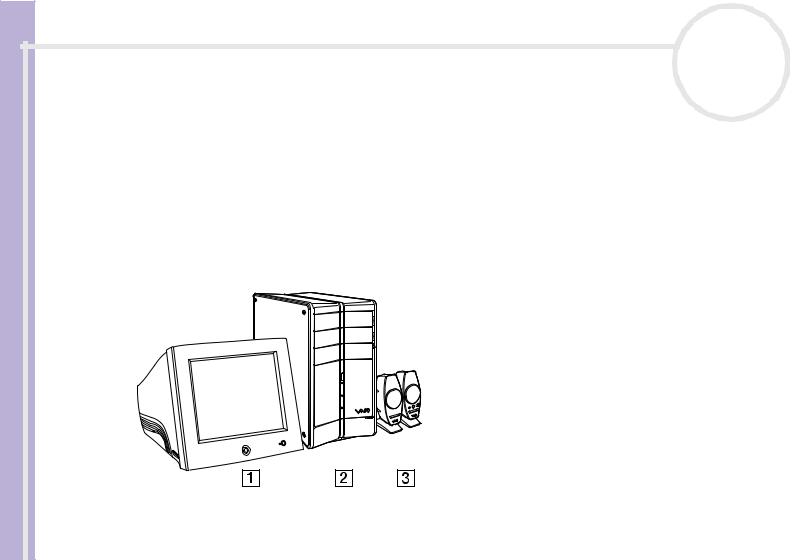
Using your VAIO desktop |
n N |
Sony VAIO Desktop User Guide
15
Locating connectors
Please see the printed Specifications sheet to identify connectors on your model.
Starting your computer
Once you have all the components set up as described in the Getting Started guide, you can begin to use your computer.
To start up your computer, proceed as follows:
1Press the power button on your monitor to turn the display on (1).
2Press the power button on the system unit until the blue power indicator light turns on (2).
3Push the power button on the speakers to turn the sound on (3).
If you press the power button for more than four seconds, the computer will switch itself off.

Using your VAIO desktop |
n N |
|||||
|
|
|
|
|
16 |
|
|
|
|
|
|
||
Guide |
Shutting down your computer |
|||||
|
||||||
User |
It is important that you shut down your computer properly so you do not lose unsaved data. |
|
||||
Desktop |
To shut down your computer, proceed as follows: |
|
||||
|
|
|
||||
|
|
1 |
Click the Start button. |
|
||
VAIO |
2 |
Click Turn Off Computer. |
|
|||
|
The Turn off computer screen appears. |
|
||||
|
|
|
|
|||
Sony |
3 |
Click Turn Off. |
|
|||
|
Wait for your computer to turn off automatically. |
|
||||
|
|
|
|
|||
|
|
|
The power indicator turns off. |
|
||
|
|
4 |
Turn off any peripherals connected to your computer. |
|
||
Respond to any prompts warning you to save documents or to consider other users. If you are unable to shut down your computer;
-Close all software in use.
-Disconnect any USB devices.
-Press <Ctrl>+<Alt>+<Delete> at the same time. If you have not changed the default setting, you will enter the Task Manager. Select Turn Off from the Shut Down menu to turn the computer off.
Alternatively, press <Alt>+<F4> and select Turn Off from the screen that appears.
If this does not work, you can press the power button for more than four seconds. This will shut down the computer. This operation may result in loss of data.
If you want to shut down the computer for a short period only, you can save power by using the Standby mode. Go to Start, Turn Off Computer, and select Stand By (see Using power saving modes (page 54) for details).

Using your VAIO desktop
Guide |
|
|
Using the keyboard |
|||||||||||||||||||
UserDesktopVAIOSony |
|
|
This section describes the features of the VAIO keyboard. |
|||||||||||||||||||
|
|
|
||||||||||||||||||||
|
|
|
|
|
|
|
|
|
|
|
|
|
|
|
|
|
|
|
|
|
|
|
|
|
|
|
|
|
|
|
|
|
|
|
|
|
|
|
|
|
|
|
|
|
|
|
|
|
|
|
|
|
|
|
|
|
|
|
|
|
|
|
|
|
|
|
|
|
|
|
|
|
|
|
|
|
|
|
|
|
|
|
|
|
|
|
|
|
|
|
|
|
|
|
|
|
|
|
|
|
|
|
|
|
|
|
|
|
|
|
|
|
|
|
|
|
|
|
|
|
|
|
|
|
|
|
|
|
|
|
|
|
|
|
|
|
|
|
|
|
|
|
|
|
|
|
|
|
|
|
|
|
|
|
|
|
|
|
|
|
|
|
|
|
|
|
|
|
|
|
|
|
|
|
|
|
|
|
|
|
|
|
|
|
|
|
|
|
|
|
|
|
|
|
|
|
|
|
|
|
|
|
|
|
|
|
|
|
|
|
|
|
|
|
|
|
|
|
|
|
|
|
|
|
|
|
|
|
|
|
|
|
|
|
|
|
|
|
|
|
|
|
|
|
|
|
|
|
|
|
|
|
|
|
|
|
|
|
|
|
|
|
|
|
|
|
|
|
|
|
|
|
|
|
|
|
|
|
|
|
|
|
|
|
|
|
|
|
|
|
|
|
|
|
|
|
|
|
n N
17
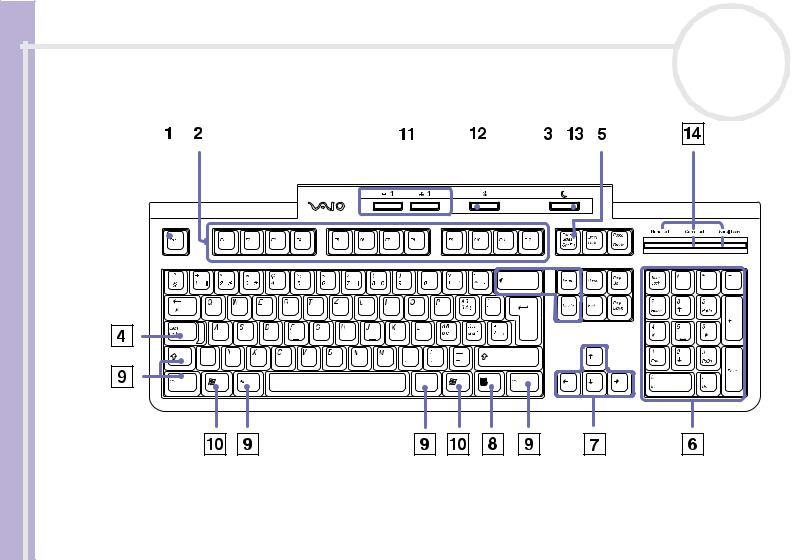
Using your VAIO desktop
Guide |
Swiss keyboard |
|||||||||||||||||||||
UserDesktopVAIOSony |
If you purchased your VAIO in Switzerland, your keyboard will have the following layout: |
|||||||||||||||||||||
|
||||||||||||||||||||||
|
|
|
|
|
|
|
|
|
|
|
|
|
|
|
|
|
|
|
|
|
|
|
|
|
|
|
|
|
|
|
|
|
|
|
|
|
|
|
|
|
|
|
|
|
|
|
|
|
|
|
|
|
|
|
|
|
|
|
|
|
|
|
|
|
|
|
|
|
|
|
|
|
|
|
|
|
|
|
|
|
|
|
|
|
|
|
|
|
|
|
|
|
|
|
|
|
|
|
|
|
|
|
|
|
|
|
|
|
|
|
|
|
|
|
|
|
|
|
|
|
|
|
|
|
|
|
|
|
|
|
|
|
|
|
|
|
|
|
|
|
|
|
|
|
|
|
|
|
|
|
|
|
|
|
|
|
|
|
|
|
|
|
|
|
|
|
|
|
|
|
|
|
|
|
|
|
|
|
|
|
|
|
|
|
|
|
|
|
|
|
|
|
|
|
|
|
|
|
|
|
|
|
|
|
|
|
€
<
> \
Alt gr
n N
18
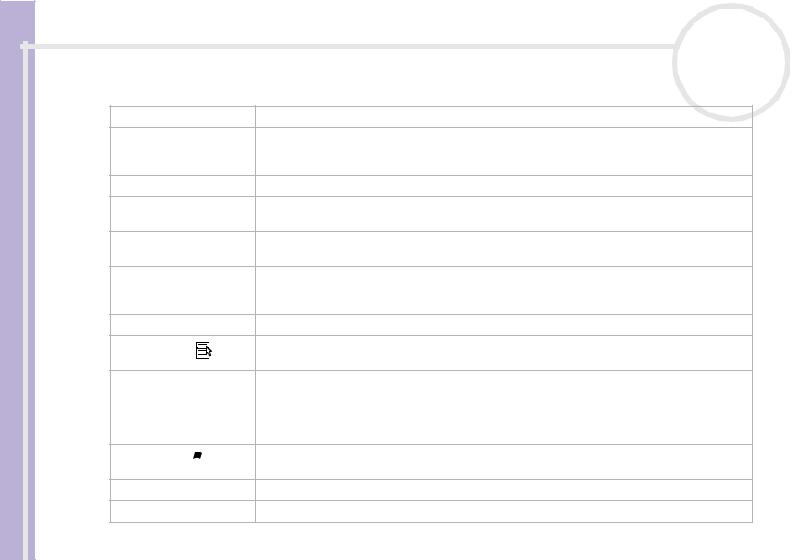
Using your VAIO desktop |
|
|
Guide |
Keys |
|
User |
|
|
Escape key (1) |
|
|
Desktop |
|
|
Function keys (2) |
|
|
|
|
|
VAIO |
Correction keys (3) |
|
|
|
|
Sony |
Lock keys (4) |
|
Print Screen key (5) |
|
|
|
|
|
|
Numeric keypad area (6) |
|
|
Navigation keys (7) |
|
|
Application key |
(8) |
|
Operator keys (9) |
|
Windows® key  (10)
(10)
Volume buttons (11)
Mute button (12)
n N
19
Descriptions
The <Esc> (Escape) key is used to cancel commands.
The twelve function keys along the top of the keyboard are used to perform designated tasks. For example, in many applications, <F1> is the Help key. The task associated with each function key may vary from one application to another.
The <Insert>, <Back Space> and <Delete> keys enable you to make corrections when typing.
Press <Caps Lock> once to activate the uppercase characters. Use the <Num Lock> key to activate the numerical keypad.
The <Prt Sc> key takes an electronic snapshot of the screen and moves it to the Windows® Clipboard. You can then paste the screenshot into a document and print it.
This contains the keys found on a typical calculator. Use the numeric keypad area to type numbers or to perform mathematical calculations such as addition and subtraction. Note that you must press the <Num Lock> key to activate the keypad.
These keys enable you to move the cursor on the screen.
The <Application> key displays a shortcut menu; pressing this key is equivalent to clicking the right mouse button.
Several keys are used in combination with at least one other key: <Ctrl>, <Alt> and <Shift>. When held down at the same time as another key, the <Ctrl> (Control) and <Alt> (Alternate) keys offer another way to execute commands. For example, in many applications, instead of choosing the Save command from a menu, you can hold down <Ctrl> and press <S> (referred to as <Ctrl>+<S>). The <Shift> key is used to type capital letters or special symbols such as @ and $.
The key with the Windows® logo displays the Windows® Start menu; it is equivalent to clicking the Start button on the taskbar.
Press the - button to decrease volume, and the + button to increase.
Press once to mute the system sound, press again to restore the sound.

Using your VAIO desktop |
n N |
Sony VAIO Desktop User Guide
|
|
|
|
|
|
20 |
|
|
|
|
|
|
|
||
|
|
|
|
|
|
||
|
|
Keys |
|
|
Descriptions |
||
|
|
|
|
|
|
||
|
|
Standby button (13) |
|
Press this button either to start up your computer, or to enter Standby mode, or to resume from a |
|||
|
|
|
|
|
power saving mode. |
||
|
|
|
|
|
|
||
|
|
Indicator LEDs (14) |
|
A green light indicates whether the Num Lock, Caps Lock, and Scroll Lock functions are active. |
|||
|
|
|
|
|
|
||
|
|
Combinations and functions with the Windows® key |
|||||
|
|
Combinations |
|
Function |
|||
|
|
|
|
|
|
||
|
|
+ <F1> |
|
Displays Windows® Help and Support Center. |
|
||
|
|
|
|
|
|
||
|
|
+ <Tab> |
|
Switches the selected button on the taskbar. |
|
||
|
|
|
|
|
|
||
|
|
+ <D> |
|
Displays the desktop. |
|
||
|
|
|
|
|
|
||
|
|
+ <E> |
|
Displays My Computer. |
|
||
|
|
|
|
|
|
||
|
|
+ <F> |
|
Displays the Search Results window to find a file or folder. This is equivalent to selecting Search |
|
||
|
|
|
|
from the Start menu. |
|
||
|
|
|
|
|
|||
|
|
+ <Ctrl> + <F> |
Displays the Search Results - Computers window where you can locate other computers. |
|
|||
|
|
|
|
|
|
||
|
|
+ <L> |
|
Locks your computer. |
|
||
|
|
|
|
|
|
||
|
|
+ <M> |
|
Minimises all displayed windows. |
|
||
|
|
|
|
|
|
||
|
|
<Shift> + |
+ <M> |
Returns all minimised windows to their previous size. |
|
||
|
|
|
|
|
|
||
|
|
+ <R> |
|
Displays the Run window. This is equivalent to selecting Run from the Start menu. |
|
||
|
|
|
|
|
|
||
|
|
+ <U> |
|
Launches the Windows® Utility Manager. |
|
||
|
|
|
|
|
|
|
|
|
|
|
|
|
|
|
|

Using your VAIO desktop |
n N |
Sony VAIO Desktop User Guide
|
|
|
|
|
21 |
|
|
|
|
|
|
|
|
Indicators |
|
|
|
|
|
|
|
|
|
|
|
Light |
On |
Off |
|
|
|
|
|
|
|
|
|
Num Lock |
Turns on when the number keys in the numeric keypad |
Turns off when the alphanumeric character keys in the |
|
|
|
|
are active. |
keypad area are active. |
|
|
|
|
|
|
|
|
|
Caps Lock |
Turns on when the letters appear in uppercase as you |
Turns off when the letters appear in lowercase as you |
|
|
|
|
type. The <Shift> key lowers the case of typed letters |
type (unless you hold down the <Shift> key). |
|
|
|
|
when Caps Lock is on. |
|
|
|
|
|
|
|
|
|
|
Scroll Lock |
Turns on when the screen scrolls differently (not all |
Turns off when the information moves across the |
|
|
|
|
applications support this function). |
display normally. |
|
|
|
|
|
|
|
|
|
|
|
|
|
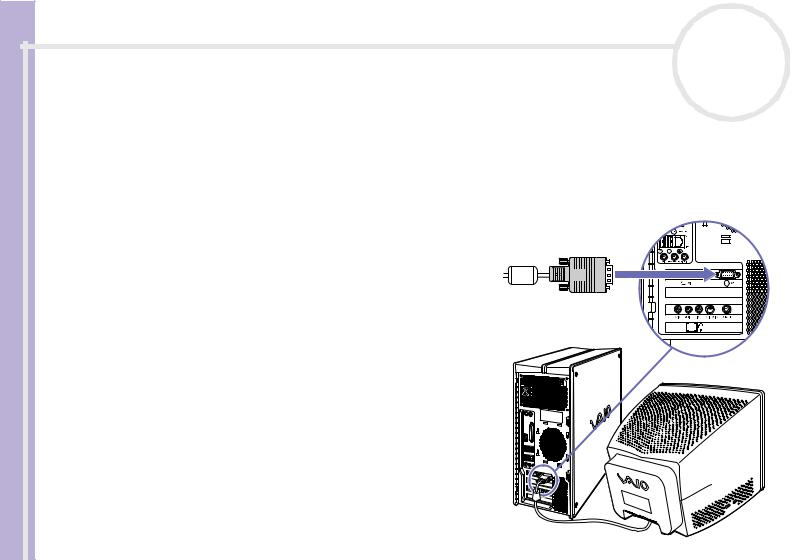
Using your VAIO desktop |
n N |
Sony VAIO Desktop User Guide
22
Setting up the monitor
If your VAIO desktop is delivered with a monitor, it may be delivered with a digital 15" or 17'' LCD (XGA TFT) monitor or with a common analogue CRT monitor, depending on your model and vendor.
For more information on how to use your delivered monitor, refer to the user manual that came with it. You can also refer to the section Connecting an external display (page 59).
Connecting the monitor
To connect your monitor, proceed as follows:
1 Plug one end of the monitor cable into the back panel of your computer.
2 Plug the other end of the monitor cable into the back of your monitor.
The monitor is now ready for use.
There are two ports: one for DVI screens and one for common VGA and CRT screens. Make sure you are using the appropriate connector.
This illustration may not correspond entirely to the configuration of your model. Please check the section Back Panel of your printed Specifications sheet to see where the ports are exactly.

Using your VAIO desktop |
n N |
Sony VAIO Desktop User Guide
23
Using the TV function
For details on using Sony’s Giga Pocket software, please see the dedicated online guide.
Your computer has been equipped with a TV-tuner board. In combination with Sony's Giga Pocket software, it allows you to:
Watch, record and play back analogue broadcasted cable and terrestrial TV-programs, all by remote control;
Digitise analogue video and audio using the S-Video or composite and audio inputs;
Manage your video units (capsules), preview them and create multiple folders;
Set up a timer to record channels at a repeated time;
Suspend viewing TV (time-shifting);
Stream your recorded TV contents via Ethernet (or WLAN) to connected PCs;
Export your video capsules to MPEG2, MPEG1 and DVI-AVI-files;
View recorded clips on client PCs located in other rooms using PicoPlayer.
Copyright protection
People who create artistic works such as music are entitled to a "copyright", meaning that they have exclusive rights to dictate how their work is used. When they are created, artistic works are automatically protected by a copyright without having to submit notification or registration, and may not be used without the permission of the person who created the work.
This product incorporates copyright protection technology that is protected under Macrovision Corporation and other rights owners, meaning you cannot record materials protected by copyright. Music and films etc. that you record at home are for personal use only.
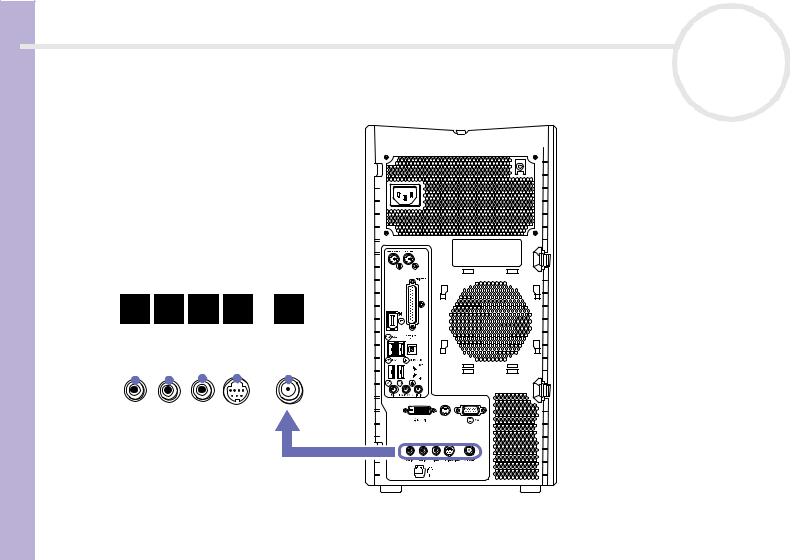
Using your VAIO desktop
Guide |
|
|
Starting to use Giga Pocket |
|
|
|
|
|||||||||||||||||||||||||||||
|
|
|
|
|
|
|||||||||||||||||||||||||||||||
UserDesktopVAIOSony |
|
|
The following ports are located on the back of your desktop: |
|
|
|
|
|||||||||||||||||||||||||||||
|
|
|
|
|
|
|
||||||||||||||||||||||||||||||
|
|
|
|
|
|
|
|
|
|
|
|
|
|
|
|
|
|
|
|
|
|
|
|
|
|
|
|
|
|
|
|
|
|
|
|
|
|
|
|
|
|
|
|
|
|
|
|
|
|
|
|
|
|
|
|
|
|
|
|
|
|
|
|
|
|
|
|
|
|
|
|
|
|
|
|
|
|
|
|
|
|
|
|
|
|
|
|
|
|
|
|
|
|
|
|
|
|
|
|
|
|
|
|
|
|
|
|
|
|
|
|
|
|
|
|
|
|
|
|
|
|
|
|
|
|
|
|
|
|
|
|
|
|
|
|
|
|
|
|
|
|
|
|
|
|
|
|
|
|
|
|
|
|
|
|
|
|
|
|
|
|
|
|
|
|
|
|
|
|
|
|
|
|
|
|
|
|
|
|
|
|
|
|
|
|
|
|
|
|
|
|
|
|
|
|
|
|
|
|
|
|
|
|
|
|
|
|
|
|
|
|
|
|
|
|
|
|
|
|
|
|
|
|
|
|
|
|
|
|
|
|
|
|
|
|
|
|
|
|
|
|
|
|
|
|
|
|
|
|
|
|
|
|
|
|
|
|
|
|
|
|
|
|
|
|
|
|
|
|
|
|
|
|
|
|
|
|
|
|
|
|
|
|
|
|
|
|
|
|
|
|
|
|
|
|
|
|
|
|
|
|
|
|
|
|
|
|
|
|
|
|
|
|
|
|
|
|
|
|
|
|
|
|
|
|
|
|
|
|
|
|
|
|
|
|
|
|
|
|
|
|
|
|
|
|
|
|
|
|
|
|
|
|
|
|
|
|
|
|
|
|
|
|
|
|
|
|
|
|
|
|
|
|
|
|
|
|
|
|
|
|
|
|
|
|
|
|
|
|
|
|
|
|
|
|
|
|
|
|
|
|
|
|
|
|
|
|
|
|
|
|
|
|
|
|
|
|
|
|
|
|
|
|
|
|
|
|
|
|
|
|
|
|
|
|
|
|
|
|
|
|
|
|
|
|
|
|
|
|
|
|
|
|
|
|
|
|
|
|
|
|
|
|
|
|
|
|
|
|
|
|
|
|
|
|
|
|
|
|
|
|
|
|
|
|
|
|
|
|
|
|
|
|
|
|
|
|
|
|
|
|
|
|
|
|
|
|
|
|
|
|
|
|
|
|
|
|
|
|
|
|
|
|
|
|
|
|
|
|
|
|
|
|
|
|
|
|
|
|
|
|
|
|
|
|
|
|
|
|
|
|
|
|
|
|
|
|
|
|
|
|
|
|
|
|
|
|
|
|
|
|
|
|
|
|
|
|
|
|
|
|
|
|
|
|
|
|
|
|
|
|
|
|
|
|
|
|
|
|
|
|
|
|
|
|
|
|
|
|
|
|
|
|
|
|
|
|
|
|
|
|
|
|
|
|
|
|
|
|
|
|
|
|
|
|
|
|
|
|
|
|
|
|
|
|
|
|
|
|
|
|
|
|
|
|
|
|
|
|
|
|
|
|
|
|
|
|
|
|
|
|
|
|
|
|
|
|
|
|
|
|
|
|
|
|
|
|
|
|
|
|
|
|
|
|
|
|
|
|
|
|
|
|
|
|
|
|
|
|
|
|
|
|
|
|
|
|
|
|
|
|
|
|
|
|
|
|
|
|
|
|
|
|
|
|
|
|
|
|
|
|
|
|
|
|
|
|
|
|
|
|
|
|
|
|
|
|
|
|
|
|
|
|
|
|
|
|
|
|
|
|
|
|
|
|
|
|
|
|
|
|
|
|
|
|
|
|
|
|
|
|
|
|
|
|
|
|
|
|
|
|
|
|
|
|
|
|
|
|
|
|
|
|
|
|
|
|
|
|
|
|
|
|
|
|
|
|
|
|
|
|
|
|
|
|
|
|
|
|
|
|
|
|
|
|
|
|
|
|
|
|
|
|
|
|
|
|
|
|
|
|
|
|
|
|
|
|
|
|
|
|
|
|
|
|
|
|
|
|
|
|
|
|
|
|
|
|
|
|
|
|
|
|
|
|
|
|
|
|
|
|
|
|
|
|
|
|
|
|
|
|
|
|
|
|
|
|
|
|
|
|
|
|
|
n N
24
1 |
Right audio-in channel |
|
|
2 |
Left audio-in channel |
|
|
3 |
Video-in |
|
|
4 |
S-Video-In port |
|
|
5 |
Antenna-in port |
|
|

Using your VAIO desktop |
n N |
Sony VAIO Desktop User Guide
25
To connect terrestrial or cable TV to your computer, proceed as follows:
1Plug one end of your antenna cable / cable-TV cable (not supplied) into the Antenna port (5) on the back of the computer.
2Plug the other end in the TV wall socket.
To connect an external video/audio source (such as a video camera, VCR or DVD player), proceed as follows:
1Connect your video/audio device’s video cable to the S-Video (4) or Video-in port (3), depending on the type of cable supplied with the external device.
If the video source has both a composite and an S-Video output, you are recommended to use the S-Video output as this will result in higher quality video.
2Connect the left and right audio cables into the right (1) and left (2) audio channel ports.
Please note relevant directives with regards to TV licensing regulations in your own country.
This illustration may not correspond entirely to the configuration of your model. Please check the section Back Panel of your printed Specifications sheet to see where the ports are exactly.
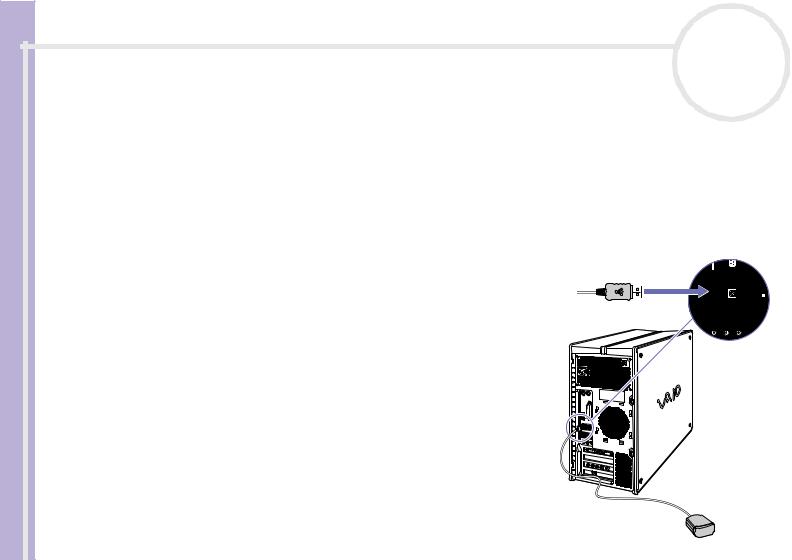
Using your VAIO desktop |
n N |
Sony VAIO Desktop User Guide
26
Using the remote control
Your VAIO comes with a remote control with which you can control Giga Pocket, VAIO Media, SonicStage and PowerDVD for VAIO. Before you can use the remote control, you must insert two AA alkaline batteries and connect the infrared receiver.
Inserting the batteries and connecting the infrared receiver
To insert the batteries, proceed as follows:
1Slide the battery cover in the direction of the arrow.
2Insert two AA alkaline batteries into the battery bay, matching the polarities (+ to +, - to -).
3Close the battery cover and slide it securely back into place.
To connect the supplied USB infrared receiver, simply plug the end of its USB cable into one of the computer’s USB ports, as shown:
When using the remote control, always point it directly at the receiver.
This illustration may not correspond entirely to the configuration of your model. Please check the section Back Panel of your printed Specifications sheet to see where the ports are exactly.
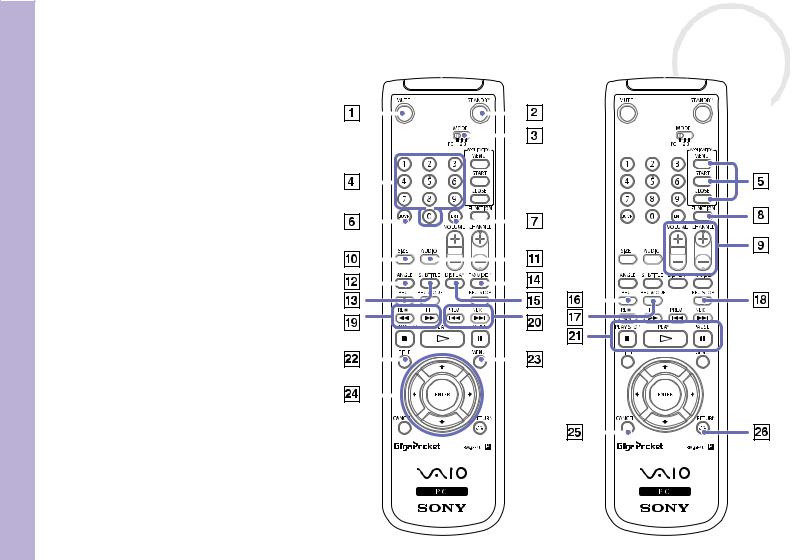
Using your VAIO desktop
Guide |
|
|
The following illustration and |
||||||||||||
User |
|
|
table describe the remote control’s |
||||||||||||
|
|
features. Please see Giga Pocket’s |
|
|
|
|
|
|
|
|
|
|
|
|
|
|
|
|
|
|
|||||||||||
DesktopVAIOSony |
|
|
online Help files, within the |
||||||||||||
|
|
|
|||||||||||||
|
|
|
software itself, for more details. |
|
|
|
|
|
|||||||
|
|
|
|
|
|
|
|
|
|
|
|
|
|
|
|
|
|
|
|
|
|
|
|
|
|
|
|
|
|
|
|
|
|
|
|
|
|
|
|
|
|
|
|
|
|
|
|
|
|
|
|
|
|
|
|
|
|
|
|
|
|
|
|
|
|
|
|
|
|
|
|
|
|
|
|
|
|
|
|
|
|
|
|
|
|
|
|
|
|
|
|
|
|
|
|
|
|
|
|
|
|
|
|
|
|
|
|
|
|
|
|
|
|
|
|
|
|
|
|
|
|
|
|
|
|
|
|
|
|
|
|
|
|
|
|
|
|
|
|
|
|
|
|
n N
27

Using your VAIO desktop
Guide |
|
|
|
|
Button |
|
|
|
|
||
User |
|
|
|
|
|
|
|
|
MUTE |
||
|
|
|
1 |
||
Desktop |
|
|
|
2 |
STANDBY |
|
|
|
|
||
VAIO |
|
|
|
3 |
MODE switch |
|
|
|
|
|
|
Sony |
|
|
|
4 |
Numbered buttons |
|
|
|
|
||
|
|
|
|
|
1 - 0 |
|
|
|
|
5 |
Application |
|
|
|
|
|
buttons |
|
|
|
|
6 |
JUMP |
|
|
|
|
7 |
ENT |
|
|
|
|
8 |
FUNCTION |
|
|
|
|
9 |
VOLUME and |
|
|
|
|
|
CHANNEL |
|
|
|
|
10 |
SIZE |
|
|
|
|
11 |
AUDIO |
|
|
|
|
12 |
ANGLE |
|
|
|
|
|
|
|
|
|
|
|
|
n N
28
Function
Temporarily mutes the sound. Pressing it again restores the sound.
Puts your computer into Standby mode. See Using power saving modes (page 54). You cannot put your computer into Standby mode while Giga Pocket or Giga Pocket Server is running; approximately 5 minutes before timer recording starts; or just after the expiration date of a Video Capsule.
If you are using more than one desktop with the remote control, this switches control between the computers. Set the switch from 1 to 3. whichever value is set in the target computer’s Remote Commander Setting software. 1 is the default if you are just using one desktop.
Used to select channels. Press the ENT button after you press these number buttons. You can select up to 3-digit numbers. You cannot change channels while recording.
These buttons are used when operating Giga Pocket.
Pressing MENU displays a menu on the computer screen. Press this button again to select software from the menu.
START launches the software that was selected with the MENU button.
CLOSE exits the software that was selected with the MENU button.
Goes back to the previous channel you selected. Press it again to return to the current channel.
Selects the channel. Press it after pressing the channel number buttons.
Press this button while Giga Pocket is selected through the MENU button to switch from the TV/recording deck to the playback deck.
Used to adjust the volume and select a channel. You cannot change channels while recording.
Displays Giga Pocket in full-screen size. Pressing the button again displays Giga Pocket in its original size.
Selects the sound mode. Each time you press this button, the sound mode changes as follows: Mono >
Stereo > Channel A > Channel B > Mono.
This is a universal DVD playback function and is not used for Giga Pocket. This button changes the camera angle while playing back DVDs, as long as this function is supported by the DVD movie.

Using your VAIO desktop |
|
n N |
|||||
|
|
|
|
|
|
29 |
|
|
|
|
|
|
|
||
Guide |
|
|
|
|
|||
|
|
Button |
Function |
||||
User |
|
|
|||||
|
|
|
|
|
|||
13 |
SUBTITLE |
This is a universal DVD playback function and is not used for Giga Pocket. Use it to turn on/off the subtitles |
|||||
|
|
||||||
Desktop |
|
|
|
or change the language of the subtitles while playing back DVDs, as long as this function is supported by |
|||
|
|
|
from a device connected to the external input port such as a digital device or VCR. You cannot change input |
||||
|
|
|
|
|
the DVD movie. |
||
|
|
14 |
TV/VIDEO |
Each time you press this button, the TV/Recording deck images change to the television feed, or to those |
|||
VAIO |
|
|
|
sources while recording. |
|||
|
|
|
|
||||
15 |
DISPLAY |
Displays the TV/Recording deck and playback deck screens when Giga Pocket is in full-screen mode. |
|||||
Sony |
|
|
|
Pressing the button again hides both the TV/Recording deck and playback deck. |
|||
|
|
|
|
||||
16 |
REC |
Starts recording the TV programs you are watching on the TV/Recording deck. |
|||||
|
|
|
|
|
|
||
|
|
17 |
REC MODE |
Selects the recording mode. Each time you press this button, the recording mode changes from SP |
|||
|
|
|
|
|
(Standard Play) to HQ (High Quality). For details on the recording mode, refer to the Giga Pocket Help files. |
||
|
|
|
|
|
|
||
|
|
18 |
REC STOP |
Stops recording. |
|||
|
|
|
|
|
|
||
|
|
19 |
REW and FF |
Used to rewind or fastforward the video tape while playing back Video Capsules. |
|||
|
|
|
|
|
|
||
|
|
20 |
PREV and NEXT |
These are DVD playback functions and are not used for Giga Pocket. Use these buttons to skip to the next |
|||
|
|
|
|
|
or go back to the previous chapter, as long as the DVD supports this function. |
||
21PLAY STOP, PLAY Used to stop playback, play, and pause playback of Video Capsules appearing on the playback deck. and PAUSE
22 |
TITLE |
This is a universal DVD playback function and is not used for Giga Pocket. The function of this button can |
|
|
vary depending on the DVD you are watching. |
|
|
|
23 |
MENU |
Displays the Select Video Capsules window. Pressing it again hides the window. For details, refer to the |
|
|
Giga Pocket Help files and the online Giga Pocket manual. |
|
|
|
24 |
Up/Down/Left/ |
Used to select a Cabinet or Video Capsule in the Select Video Capsules window. For details, refer to the |
|
Right and ENTER |
Giga Pocket Help files and the online Giga Pocket manual. |
|
|
Also used to operate the film roll when playing back Video Capsules on the playback deck. For details, refer |
|
|
to the Giga Pocket Help files and the online Giga Pocket manual. |
